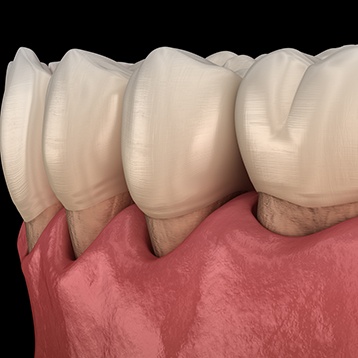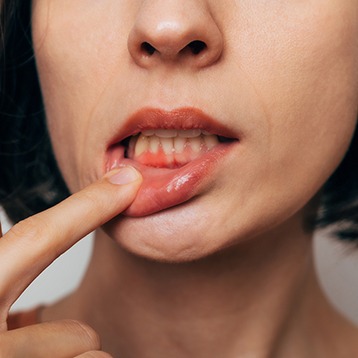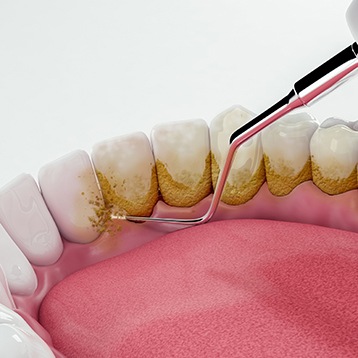Gum Disease Treatment – Wylie, TX
Preserve Your Smile by Protecting Your Gums!

Your gums are responsible for many different functions – they do so much more than merely keep your teeth properly anchored! They also protect the roots of the teeth, which are far more susceptible to infection and breakdown from bacteria. Additionally, they ensure that your teeth and other oral structures receive all the nutrients they need. Gum disease can bring all of these benefits to a screeching halt – and it might even trigger additional problems with your teeth or other systems throughout your body! If you suffer from gum disease, regardless of the severity, you shouldn’t hesitate to contact our office for an exam and possible treatment.
Why Choose Wylie Family Dentistry for Gum Disease Treatment??
- Skilled Dentist with Several Years of Experience
- Personalized Treatment Plans for All Patients
- Insurance-Friendly & Financing Options Available
What Is Gum Disease?

Gum disease is an infection of the gums and supportive tissues that surround the teeth, and most of the time, it’s caused by plaque and tartar buildup resulting from poor oral hygiene. It can lead to permanent damage, tooth loss, and other serious health conditions. It typically is categorized into two main stages: gingivitis, which is its earliest and most treatable stage, as well as periodontitis, which is more advanced and cannot be truly cured, only managed. There are multiple factors that can increase your risk of gum disease, with some of the most prevalent including smoking, using tobacco products, not practicing good oral hygiene, or even genetic factors and immune-compromising conditions.
Symptoms of Gum Disease

The key to maintaining healthy gums is recognizing the symptoms of gum disease and knowing when assistance is needed. If you notice any of the symptoms listed below, don’t hesitate to schedule a visit with our team:
- Bleeding gums, especially when brushing/flossing
- Tender, swollen, or inflamed gum tissue that’s reddish or purplish in color
- Gum recession
- Pain or sensitivity when chewing
- The sensation that your teeth are loose
- Changes in your bite pattern
How Do We Treat Gum Disease?

Before we can determine the best method of treating your gum disease, we’ll need to thoroughly examine your smile to determine the severity of the condition. We’ll also discuss your symptoms and lifestyle with you, to get a better grasp on things. From there, we can begin reviewing your treatment options.
Scaling & Root Planing

Once gum disease has passed the gingivitis stage, improved oral care typically isn’t enough to reverse the condition. This is often due to plaque and decay extending beneath the gum line and attacking the roots of the teeth. Fortunately, scaling and root planing are a pair of procedures that can be used to address this advanced form of gum disease. It involves carefully removing all of the plaque from this region using special instruments, before smoothing the roots of the teeth so that the gum tissue can begin reattaching itself.
Do You Need Scaling & Root Planing?

Scaling and root planing is sometimes referred to as a “deep cleaning,” which essentially describes exactly what it is. When signs of gum disease are detected, including bleeding, swelling, and inflammation, we will try to address it right away to keep it from progressing and resulting in lasting harm to your smile. The goal of scaling and root planing is to remove bacteria that have accumulated around or beneath your gumline. We will also smooth down the roots of the teeth to help the gums reattach and heal more efficiently.
The Process of Scaling & Root Planing

Scaling and root planing is comprised of two parts. They usually happen over two separate appointments. The “scaling” portion is when our dental team scrapes away plaque and tartar that accumulate along the gumline using specialized dental instruments. We will also target the areas beneath the gumline where bacteria build up.
After the scaling portion is complete, we will move on to the “root planing.” This is when we smooth down sections of the teeth beneath the gumline to help them adhere to your teeth. This helps to speed up the healing process, making it more difficult for the bacteria to build up again. Ultimately, this process reduces your risk of developing gum disease again.
Aftercare Tips for Scaling & Root Planing

It’s normal for your gums to feel sore following scaling and root planing. Your gums may also be a little bit inflamed. This is temporarily following your treatment and should resolve itself in a few weeks. Here are a few tips to help your gums heal quickly:
- Brush your teeth twice a day using a soft-bristled toothbrush and fluoridated toothpaste.
- Rinse your mouth with salt water after meals to prevent irritation.
- Floss thoroughly every day.
- Stick to a soft diet for the first 48 hours following your treatment.
- Avoid foods and beverages that are spicy, acidic, or hot.
- Refrain from intense physical activity after your treatment.
